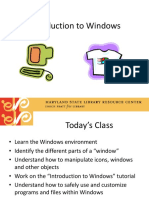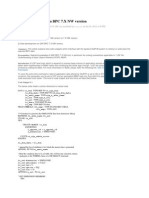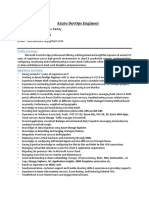0 ratings0% found this document useful (0 votes)
83 viewsLesson 1 Intro To MS Word 2010
Lesson 1 Intro To MS Word 2010
Uploaded by
Ja H MesThis document provides an overview of the Microsoft Word interface and teaches how to start a new document. It identifies the main parts of the Word window including the quick access toolbar, ribbon tabs, title bar, file tab, ribbon, groups, insertion point, document window, status bar, dialog box launcher, view options, zoom slider, vertical scroll bar, and scroll box. The objective is for students to understand how to use the Word window and know how to start, save, and find a new document.
Copyright:
© All Rights Reserved
Available Formats
Download as PDF, TXT or read online from Scribd
Lesson 1 Intro To MS Word 2010
Lesson 1 Intro To MS Word 2010
Uploaded by
Ja H Mes0 ratings0% found this document useful (0 votes)
83 views10 pagesThis document provides an overview of the Microsoft Word interface and teaches how to start a new document. It identifies the main parts of the Word window including the quick access toolbar, ribbon tabs, title bar, file tab, ribbon, groups, insertion point, document window, status bar, dialog box launcher, view options, zoom slider, vertical scroll bar, and scroll box. The objective is for students to understand how to use the Word window and know how to start, save, and find a new document.
Original Title
LESSON 1 INTRO TO MS WORD 2010
Copyright
© © All Rights Reserved
Available Formats
PDF, TXT or read online from Scribd
Share this document
Did you find this document useful?
Is this content inappropriate?
This document provides an overview of the Microsoft Word interface and teaches how to start a new document. It identifies the main parts of the Word window including the quick access toolbar, ribbon tabs, title bar, file tab, ribbon, groups, insertion point, document window, status bar, dialog box launcher, view options, zoom slider, vertical scroll bar, and scroll box. The objective is for students to understand how to use the Word window and know how to start, save, and find a new document.
Copyright:
© All Rights Reserved
Available Formats
Download as PDF, TXT or read online from Scribd
Download as pdf or txt
0 ratings0% found this document useful (0 votes)
83 views10 pagesLesson 1 Intro To MS Word 2010
Lesson 1 Intro To MS Word 2010
Uploaded by
Ja H MesThis document provides an overview of the Microsoft Word interface and teaches how to start a new document. It identifies the main parts of the Word window including the quick access toolbar, ribbon tabs, title bar, file tab, ribbon, groups, insertion point, document window, status bar, dialog box launcher, view options, zoom slider, vertical scroll bar, and scroll box. The objective is for students to understand how to use the Word window and know how to start, save, and find a new document.
Copyright:
© All Rights Reserved
Available Formats
Download as PDF, TXT or read online from Scribd
Download as pdf or txt
You are on page 1of 10
LESSON 1
Introduction to Microsoft word
GEI004 Lab – Advanced Productivity Tools
Objective
By the end of this lesson, the student will:
• Identify the different parts of MS Word 2010 Window
• Be able to understand the different functionality of MS Word 2010
Window.
• Know how to start a new document in Microsoft Word, save it, and be
able to find it later.
What is Microsoft Word
• Microsoft Word is word processing
software. It is developed by Microsoft and
is part of Microsoft Office Suite. It
enables you to create, edit and save
professional documents like letters and
reports.
• Originally developed by Charles Simonyi
and Richard Brodie, it was first released
in 1983.
MICROSOFT WORD WINDOW
MICROSOFT WORD WINDOW
1. Quick Access Toolbar (QAT)
• Displays buttons to perform frequently
used commands with a single click.
• Frequently used commands in Word
include Save, Undo, Redo, and Print.
• For commands that you use frequently,
you can add additional buttons to
the Quick Access Toolbar
2. Tab
• Display across the top of the Ribbon,
and each tab relates to a type of
activity; for example, laying out a page.
MICROSOFT WORD WINDOW
3. Title bar
• Displays the name of the document and the
name of the program.
4. Program-Level Control Buttons
• The buttons on the right edge of the title
bar that minimize, restore or close the
program.
5. File Tab
• Displays Microsoft Office Backstage view,
which is a centralized space for all of your
file management tasks such as opening,
saving, printing, publishing, or sharing a
file.
MICROSOFT WORD WINDOW
6. Ribbon
• Organizes commands on tabs, and
then groups the commands by topic
for performing related document
tasks.
7. Group name
• Indicate the name of the groups of
related commands on the displayed
tab.
8. Insertion point
• Indicates, with a blinking vertical
line, where text or graphics will be
inserted
MICROSOFT WORD WINDOW
9. Word document window
• Displays the active document.
10. Status bar
• Displays, on the left side, the page
and line number, word count, and the
Proof button. On the right side,
displays buttons to control the look
of the window.
11. Dialog box launcher
• A small icon that displays to the
right of some group names on the
Ribbon; it launches a dialog box.
MICROSOFT WORD WINDOW
12. Print Layout button
• The default view, which displays the
page borders and the document as it
will appear when printed.
13. View Options
• Contains buttons for viewing the
document in Print Layout, Full Screen
Reading, Web Layout, Outline, or Draft
views, and also displays controls to
Zoom Out and Zoom In.
MICROSOFT WORD WINDOW
14. Zoom Slider
• The Zoom Slider increases or decreases the
viewing area.
15. Vertical scroll bar
• Enables you to move up and down in a
document to display text that is not visible.
16. Scroll box
• Provides a visual indication of your location
in a document. You can use the mouse to
drag a document up and down to reposition
the document.
You might also like
- Agile For Dummies EbookDocument75 pagesAgile For Dummies EbookMiloslav Pekař100% (2)
- Online Blood Donation Management System ReportDocument66 pagesOnline Blood Donation Management System ReportAmit Gupta56% (16)
- Project Documentation - College Social MediaDocument73 pagesProject Documentation - College Social MediaKishore SNo ratings yet
- Ms Word 2016 in 90 Pages PDFDocument108 pagesMs Word 2016 in 90 Pages PDFAshraf Atique100% (1)
- Introduction To Windows PDFDocument24 pagesIntroduction To Windows PDFRaymoon Twopass DaysNo ratings yet
- Master Miro Quickly: Expert Techniques to Leverage Visual Thinking Every DayFrom EverandMaster Miro Quickly: Expert Techniques to Leverage Visual Thinking Every DayRating: 5 out of 5 stars5/5 (1)
- Lecture 4-Introduction To Word Processing 1 - 2024Document41 pagesLecture 4-Introduction To Word Processing 1 - 2024tshepangotladisaNo ratings yet
- Module 1-6 Introductionto Word ProcessingDocument118 pagesModule 1-6 Introductionto Word ProcessingReshid JewarNo ratings yet
- Week 4 Empowerment TechnologyDocument46 pagesWeek 4 Empowerment TechnologyHarley LausNo ratings yet
- Week 4 Empowerment TechnologyDocument49 pagesWeek 4 Empowerment TechnologyNoel Buctot100% (1)
- Intro To Word ProcessingDocument41 pagesIntro To Word ProcessingJemima Mia Kilat ForonesNo ratings yet
- Booklet Added Microsoft Features Not Finish No Pictures Yet 1Document59 pagesBooklet Added Microsoft Features Not Finish No Pictures Yet 1Keziah CodillaNo ratings yet
- Unit 2 - Word Processing Software UpdateDocument280 pagesUnit 2 - Word Processing Software Updatesokapatrick0No ratings yet
- IT111 Modules 5.1 5.2 Office Productivity ToolsDocument68 pagesIT111 Modules 5.1 5.2 Office Productivity Toolsgilvantalosig0618No ratings yet
- Microsoft WordDocument11 pagesMicrosoft WordRitz SantiagoNo ratings yet
- MS Word TrainingDocument46 pagesMS Word TrainingMJNo ratings yet
- Practical Test No.1Document8 pagesPractical Test No.1Olsen SoqueñaNo ratings yet
- To Microsoft Word: Prepared By: TLE-ICT Grade 7 TeachersDocument14 pagesTo Microsoft Word: Prepared By: TLE-ICT Grade 7 TeachersMichelle Arnon100% (1)
- Theory Word 2016Document34 pagesTheory Word 2016Raja PrasantNo ratings yet
- MS Word 2007 TutorialDocument86 pagesMS Word 2007 Tutorialkgn1100% (18)
- Software Productivity - WordDocument36 pagesSoftware Productivity - WordJhan G CalateNo ratings yet
- MS Word Lesson 1Document42 pagesMS Word Lesson 1adrianjayatendido20No ratings yet
- For Chapter 4-5-6 Discussion On IT-101Document160 pagesFor Chapter 4-5-6 Discussion On IT-101Asi Cas JavNo ratings yet
- MSWORDDocument20 pagesMSWORDforkey loggerNo ratings yet
- Module 3-Word ProcessingDocument54 pagesModule 3-Word ProcessingEmma PreciousNo ratings yet
- Microsoft WordDocument71 pagesMicrosoft WordLeonor CorpuzNo ratings yet
- Presentation 1Document7 pagesPresentation 1juvyflores024No ratings yet
- MS-Word NotesDocument57 pagesMS-Word NotesDavidson isaackNo ratings yet
- ICT For SHS: Word Processing - Microsoft Word 2010Document23 pagesICT For SHS: Word Processing - Microsoft Word 2010Samuel Teyemensah Kubi100% (1)
- Microsoft WordDocument28 pagesMicrosoft WordMark Robert De JesusNo ratings yet
- Computer 7-2nd Grading (Powerpoint)Document23 pagesComputer 7-2nd Grading (Powerpoint)Mary Jane Blanco FioNo ratings yet
- CLASS 3 COMPUTER - Worksheet 4.2Document5 pagesCLASS 3 COMPUTER - Worksheet 4.2vmhsphysics100% (4)
- Introduction To MS Word 2010Document113 pagesIntroduction To MS Word 2010harsh.pali25No ratings yet
- Creating Documents With Word 2007: Microsoft Office 2007-Illustrated Introductory, Windows Vista EditionDocument40 pagesCreating Documents With Word 2007: Microsoft Office 2007-Illustrated Introductory, Windows Vista EditionraikevonnewacasNo ratings yet
- Microsoft Office (Word)Document101 pagesMicrosoft Office (Word)Faheem ShahNo ratings yet
- Microsoft WordDocument13 pagesMicrosoft WordSaadNo ratings yet
- MS Word - OcrDocument17 pagesMS Word - OcrFoxxy TuteNo ratings yet
- Practical ICT MaterialDocument116 pagesPractical ICT MaterialIsaac B PhiriNo ratings yet
- Session 4: Features of Microsoft Word Application 2010Document26 pagesSession 4: Features of Microsoft Word Application 2010Nash KevinNo ratings yet
- Form 2 Notes and Review QuestionsDocument127 pagesForm 2 Notes and Review QuestionswanlindguiniNo ratings yet
- Word Lesson 1 DemoDocument44 pagesWord Lesson 1 DemoAhmad Musyadad A.No ratings yet
- Microsoft Word 2016Document39 pagesMicrosoft Word 2016azazel17No ratings yet
- Comp-Prog11 Q1 Mod1 MSword 16052021Document32 pagesComp-Prog11 Q1 Mod1 MSword 16052021Uary FebNo ratings yet
- Unit 5Document4 pagesUnit 5Luis Norbert SantiagoNo ratings yet
- Microsoft Word 1Document23 pagesMicrosoft Word 1Paywand Hakeem AzizNo ratings yet
- Rock CycleDocument43 pagesRock Cyclerda405869No ratings yet
- WordDocument401 pagesWordaadrikaNo ratings yet
- Session 4 - Introduction To Sofware and Inserting ImagesDocument25 pagesSession 4 - Introduction To Sofware and Inserting Imageslorraine.kaylorNo ratings yet
- Computer Grade 8 First Quarter Week 1Document3 pagesComputer Grade 8 First Quarter Week 1BIT INTERNATIONAL COLLEGE TALIBONNo ratings yet
- Unit 2Document10 pagesUnit 2Nagalakshmi PNo ratings yet
- Web Design Portfolio Presentation in Pink Purple Orange Digitalism StyleDocument28 pagesWeb Design Portfolio Presentation in Pink Purple Orange Digitalism StyleChrisdel Ann CosteloNo ratings yet
- Introduction To MS WordDocument25 pagesIntroduction To MS WordMary Jane Blanco Fio100% (3)
- Word Processing Lesson OneDocument48 pagesWord Processing Lesson OneLinel SydneyNo ratings yet
- 8 Word ProcessorDocument64 pages8 Word ProcessorJustz CollectsNo ratings yet
- Information Technology - Unit 3 To 4 - I Year BcaDocument51 pagesInformation Technology - Unit 3 To 4 - I Year BcaBCA DepartmentNo ratings yet
- Deskprod Part1Document102 pagesDeskprod Part1benjie ausanNo ratings yet
- Lab # 1 IctDocument43 pagesLab # 1 IctShoaib MushtaqNo ratings yet
- Microsoft Word For Beginners: The Complete Guide To Using Word For All Newbies And Becoming A Microsoft Office 365 Expert (Computer/Tech)From EverandMicrosoft Word For Beginners: The Complete Guide To Using Word For All Newbies And Becoming A Microsoft Office 365 Expert (Computer/Tech)No ratings yet
- Advance Java BscIT Sem 5 2015 Paper Solution Mumbai UniversityDocument15 pagesAdvance Java BscIT Sem 5 2015 Paper Solution Mumbai UniversityRoystan Dalmeida0% (1)
- Dump 8Document7 pagesDump 8John WickNo ratings yet
- Análisis de Los 20 ArtículosDocument3 pagesAnálisis de Los 20 ArtículosFreddy Chafloque RojasNo ratings yet
- Lecture 3 - Arrays PDFDocument21 pagesLecture 3 - Arrays PDFZarak Khan MahsudNo ratings yet
- 2.1.2 - Assignment Block With BOL ObjectDocument46 pages2.1.2 - Assignment Block With BOL ObjectDiegoNo ratings yet
- CS 3305 Web Programming 2 - Term 5, 2018-2019Document10 pagesCS 3305 Web Programming 2 - Term 5, 2018-2019studyjunkyNo ratings yet
- Stqa Unit 3 NotesDocument22 pagesStqa Unit 3 Noteschandan kumar giriNo ratings yet
- 1.4 - Manual Testing ResumeDocument3 pages1.4 - Manual Testing ResumeUday SankarNo ratings yet
- FW 2 SNMPDocument3 pagesFW 2 SNMPRahmat FadliNo ratings yet
- To Agile or Not To Agile A Comparison of SoftwareDocument12 pagesTo Agile or Not To Agile A Comparison of SoftwareiFach 404No ratings yet
- Useful ABAP Code in BPC 7.X NW VersionDocument9 pagesUseful ABAP Code in BPC 7.X NW Versionits_nanda08No ratings yet
- Ionic Angular Multi App ProjectDocument14 pagesIonic Angular Multi App ProjectbussardNo ratings yet
- Atozed Forums - Intraweb Using TemplateDocument5 pagesAtozed Forums - Intraweb Using Templatefnyunuyh6No ratings yet
- A Project Report On Python Project: Degree of Bachelor of Technology Branch:-Computer Science and EngineeringDocument62 pagesA Project Report On Python Project: Degree of Bachelor of Technology Branch:-Computer Science and EngineeringKamal PanditaNo ratings yet
- Sketch Untuk WaktuSholatDocument11 pagesSketch Untuk WaktuSholatSuparnoNo ratings yet
- AWS Command Line Interface: User GuideDocument110 pagesAWS Command Line Interface: User GuideVikas BansalNo ratings yet
- 6 +Athena,+QuickSight,+EMRDocument63 pages6 +Athena,+QuickSight,+EMRAhmad HammadNo ratings yet
- A Look at Python-An Easy Way To Learn ProgrammingDocument239 pagesA Look at Python-An Easy Way To Learn Programminglongjiwokdima4No ratings yet
- Azure DevOps EngineerDocument3 pagesAzure DevOps EngineerMohammed AbdulNo ratings yet
- Computational Thinking Algorithms and ProgrammingDocument18 pagesComputational Thinking Algorithms and ProgrammingTimNo ratings yet
- Exp 6 - Dsa New1Document7 pagesExp 6 - Dsa New1jayNo ratings yet
- Basic Sections of A Web Page: Aldersgate College Instructional Module in HTML High SchoolDocument7 pagesBasic Sections of A Web Page: Aldersgate College Instructional Module in HTML High SchoolRrlopez astigNo ratings yet
- SQL Server Recursive CTEDocument6 pagesSQL Server Recursive CTEJorge TavaresNo ratings yet
- Teamcenter TC - War File CreationDocument12 pagesTeamcenter TC - War File CreationMuzammilNo ratings yet
- Malware TypesDocument14 pagesMalware Typesinfinitelyglorious2001No ratings yet
- Abe 48a - Laboratory Exercise 4Document3 pagesAbe 48a - Laboratory Exercise 4Christine Agnes MoralesNo ratings yet
- Tle Vi-Wk7Document4 pagesTle Vi-Wk7Clarise DumalayNo ratings yet

























































































